
A rose is a woody perennial flowering plant of the genus Rosa, in the family Rosaceae, or the flower it bears. There are over three hundred species and tens of thousands of cultivars. They form a group of plants that can be erect shrubs, climbing, or trailing, with stems that are often armed with sharp prickles. Flowers vary in size and shape and are usually large and showy, in colours ranging from white through yellows and reds. Most species are native to Asia, with smaller numbers native to Europe, North America, and northwestern Africa. Species, cultivars and hybrids are all widely grown for their beauty and often are fragrant. Roses have acquired cultural significance in many societies. Rose plants range in size from compact, miniature roses, to climbers that can reach seven meters in height. Different species hybridize easily, and this has been used in the development of the wide range of garden roses.

Rosa rubiginosa is a species of rose native to Europe and western Asia.

Rosa gallica, the Gallic rose, French rose, or rose of Provins, is a species of flowering plant in the rose family, native to southern and central Europe eastwards to Turkey and the Caucasus. It was one of the first species of rose to be cultivated in central Europe.
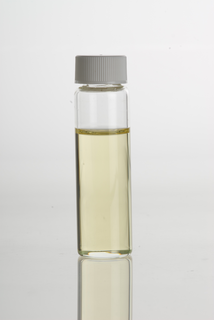
Rose oil is the essential oil extracted from the petals of various types of rose. Rose ottos are extracted through steam distillation, while rose absolutes are obtained through solvent extraction, the absolute being used more commonly in perfumery. Even with their high price and the advent of organic synthesis, rose oils are still perhaps the most widely used essential oil in perfumery.
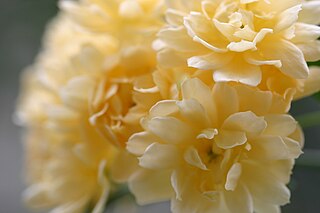
Rosa banksiae, common names Lady Banks' rose, or just Banks' rose, is a species of flowering plant in the rose family, native to central and western China, in the provinces of Gansu, Guizhou, Henan, Hubei, Jiangsu, Sichuan and Yunnan, at altitudes of 500–2,200 m (1,640–7,218 ft). The rose is named for Dorothea Lady Banks, the wife of the botanist Sir Joseph Banks.

Rosa 'Harison's Yellow', also known as R. × harisonii, the Oregon Trail Rose or the Yellow Rose of Texas, is a rose cultivar which originated as a chance hybrid in the early 19th century. It probably is a seedling of Rosa foetida and Rosa pimpinellifolia. The cultivar first bloomed at the suburban villa of George Folliott Harison, attorney, between 8th and 9th Avenues on 32nd Street, north of New York City. The site of Harison's villa is now just south of the present General Post Office. The nurseryman William Prince of Flushing, Long Island took cuttings and marketed the rose in 1830. 'Harison's Yellow' is naturalized at abandoned house sites through the west and is found as a feral rose along the Oregon Trail.
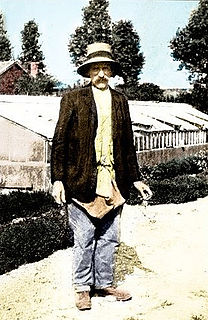
Joseph Pernet-Ducher (1859–1928) was a French rosarian and hybridizer. Born near Lyon, the son of Jean Pernet, he was a third generation rose-grower. In 1879 he began his apprenticeship in the rose-breeding business with the Ducher nursery in Lyon. In 1882, he married Marie Ducher, the owner's daughter, and adopted the name "Pernet-Ducher" to signify the two rose growing entities.
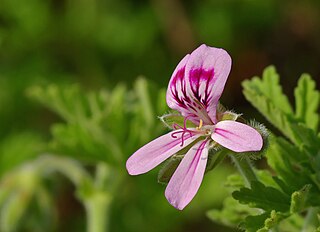
Pelargonium graveolens is a Pelargonium species native to the Cape Provinces and the Northern Provinces of South Africa, Zimbabwe and Mozambique. It is in the subgenus Pelargonium along with Pelargonium capitatum,Pelargonium crispum, Pelargonium tomentosum and Pelargonium quercifolium.

Rosa × centifolia, the Provence rose or cabbage rose or Rose de Mai is a hybrid rose developed by Dutch rose breeders in the period between the 17th century and the 19th century, possibly earlier. Its parentage includes Rosa × damascena, but it may be a complex hybrid; its exact hereditary history is not well documented or fully investigated, but it now appears that this is not the "hundred-leaved" (centifolia) rose mentioned by Theophrastus and Pliny: "no unmistakable reference can be traced earlier than about 1580". The original plant was sterile, but a sport with single flowers appeared in 1769, from which various cultivars known as centifolia roses were developed, many of which are further hybrids. Other cultivars have appeared as further sports from these roses. Rosa × centifolia 'Muscosa' is a sport with a thick covering of resinous hairs on the flower buds, from which most "moss roses" are derived. Dwarf or miniature sports have been known for almost as long as the larger forms, including a miniature moss ross 'Moss de Meaux'.

Magnolia champaca, known in English as champak, is a large evergreen tree in the family Magnoliaceae. It was previously classified as Michelia champaca. It is known for its fragrant flowers, and its timber used in woodworking.

Rosa chinensis, known commonly as the China rose or Chinese rose, alternatively known as Bengal rose or Bengal Crimson or Bengal Beauty is a member of the genus Rosa native to Southwest China in Guizhou, Hubei, and Sichuan Provinces. The first publication of Rosa chinensis was in 1768 by Nikolaus Joseph von Jacquin in Observationum Botanicarum, 3, p. 7, p. 55.

Pedro Dot (1885–1976) was a Spanish rose breeder.
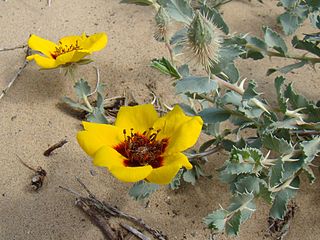
Rosa persica is an anomalous species of rose that at one time was placed in a separate genus Hulthemia. It is native to deserts and steppes from Iran and Afghanistan in the south, through Central Asia, to western Siberia in the north. Its distinctive characteristics include a simple leaf without stipules, and a distinctive flower with a darker coloured central zone. In its natural habitat it is a deep-rooted weed that suckers – growing in Iranian fields for example, where it is collected for fuel once the grain crop has been harvested – but it is difficult to grow in gardens and rarely cultivated.

Garden roses are predominantly hybrid roses that are grown as ornamental plants in private or public gardens. They are one of the most popular and widely cultivated groups of flowering plants, especially in temperate climates. Numerous cultivars have been produced, especially over the last two centuries, though roses have been known in the garden for millennia beforehand. While most garden roses are grown for their flowers, some are also valued for other reasons, such as having ornamental fruit, providing ground cover, or for hedging.

Rosa nitida, also known as the shining rose due to its glossy leaves, is a perennial species in the plant genus Rosa in the plant family Rosaceae. It is native to northeastern North America, from Connecticut north to Newfoundland and Quebec. It forms a low, suckering, deciduous shrub, growing up to a metre in height, although often less. Its stems are thin and covered in fine bristles. Its pinnate leaves have 7 to 9 shining leaflets which turn bright red, yellow and purple in the fall. Its small pink flowers appear in summer and are subtly but sweetly scented, smelling like Convallaria ("Lily-of-the-Valley"). They are followed by small, round, red hips.

Rosa 'Cécile Brünner', also known as 'Mlle Cécile Brünner', 'Sweetheart Rose', 'Malteser Rose', or 'Mignon', is a light pink polyantha rose bred in France by Marie Ducher and introduced by her son-in-law, Joseph Pernet-Ducher in 1881. Its parents were a double-flowered R. multiflora and a hybrid tea rose, either 'Souvenir d'un Ami' or a seedling of 'Mme de Tartas'. It is not clear if the rose was named after the sister (1853–1927) or daughter of Ulrich Brunner fils.

Rosa × odorata or Rosa odorata is a member of the genus Rosa native to Yunnan in Southwest China, whose taxonomy has been confused. It has been considered to be hybrid between Rosa gigantea and Rosa chinensis, or as a quite rare wild species that includes R. gigantea. The wild forms are cultivated to some extent. Cultivars were developed in China in ancient times from R. chinensis crosses, and these have been important in the ancestry of the tea-scented China roses, also called tea roses, and their descendants the hybrid tea roses.

Rosa hemisphaerica, also known as the sulphur rose, is a rose species with pale yellow flowers native to western Asia. The wild form, known as Rosa raphinii, has single flowers with five petals. A double-flowered form was one of the first yellow roses introduced to European gardens; John Bellenden Ker Gawler stated in 1815 that the species had been cultivated in England for nearly 200 years. The scent of the flowers has been described as unpleasant.

Iris florentina is the white flowered variant of Iris germanica now classified as Iris germanica nothovar. florentina. It is cultivated as an ornamental plant in temperate regions almost worldwide. Iris florentina is a rhizomatous perennial from southern Europe, mainly Italy and France. It has a thick violet-scented rhizome, sword-like green or grey-green semi-evergreen leaves, a tall branched stem, and many flowers that are white and tinged or flushed with blue, pale blue, or lavender in spring or summer, and a white and yellow beard. It is also grown to produce orris-root, a scented substance used in perfumes, soaps, tooth cleanser, and clothes washing powder. Medicinally it was used as an expectorant and decongestant. It is made from the rhizomes of Iris florentina, Iris germanica and Iris pallida.



















